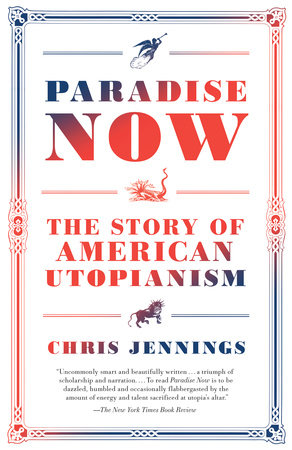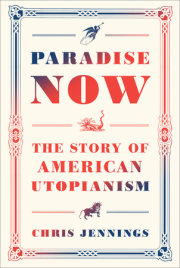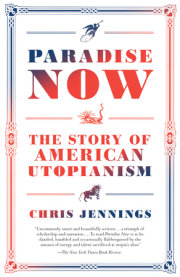THE SHAKERS
American Zion
And was Jerusalem builded here,
Among these dark Satanic Mills?
—WILLIAM BLAKE
Cottonopolis
Ann Lee was born four decades before the Dark Day, on Leap Day 1736. She was the second of eight children born to a Manchester blacksmith named John Lees and a woman whose name is lost to history. They lived in a small apartment on Toad Lane, a narrow street of smithies and alehouses.
In the mid-1700s, Manchester was ground zero for the nascent Industrial Revolution. When Lee was little, the blocks of the city were interspersed with small farm plots. Shiploads of cheap, slave-picked American cotton and a handful of technical innovations transformed the city. By the time Lee was a young woman, Manchester had begun to fill with unskilled workers from the countryside looking for work in the new mills. The invention of the spinning jenny, a machine that allowed one person to operate many yarn spindles at once, revolutionized the production of thread. Spinning, which had formerly been done by independent artisans or in the evenings by farmers’ wives, became a profitable full-time trade. The jennies spun a surplus of thread, accelerating advances in weaving technology. Groups of wealthy landowners built large mills where water- and steam-driven looms churned out inexpensive cloth. Artisan weavers and spinners could not compete. Many sold their small plots of ancestral land and joined the exodus into the city. Peasants who had previously fed themselves from their own meager acreage and often didn’t eat much at all began to live off factory wages.
Little is known of Lee’s early life. She never went to school. When she was eight, she began to work on a loom. The hagiography written by her followers after her death offers a portrait of their prophet as a severe young woman. The plump little girl relished hard work, the official record reports, and was “never addicted to play as other children.” From an early age she “was impressed with a sense of the great depravity of human nature, and of the odiousness of sin.” In the cramped apartment that Lee shared with her seven siblings, her parents’ sex life was probably on full display. It was certainly within earshot. Repulsed by the “indecent nature of sexual coition,” Lee chastised her mother for submitting to her father’s lust. This insolence earned her regular whippings. After Ann left the textile workshop, she worked as a velvet cutter. For a time she prepared fur for hats. Later she served as an assistant in a lunatic asylum.
Religion was one of the few things that was not in short supply on Toad Lane. By the time Lee was twenty-three, she and other members of her family had joined a prayer group led by Jane and James Wardley, a pair of Quaker tailors who lived in Bolton, a few miles north of Manchester. The Wardleys believed that God spoke directly to them and that the Second Coming of Christ was imminent. Like other religious dissenters of their day, they denounced the official Anglican Church as the work of the Antichrist. The group that met in the Wardleys’ home felt the Holy Ghost in their midst and acted accordingly. Disturbed by their spastic singing and dancing, their neighbors called them jumpers, shiverers, or shaking Quakers.
Much of what the Wardleys preached derived from a group of French mystics who had settled in England at the end of the seventeenth century. In 1685, Louis XIV revoked the Edict of Nantes under pressure from the Vatican and his devoutly Catholic second wife. For a century, the edict had protected the rights of Huguenot Protestants to worship openly throughout most of France, though never in Paris. In response to their sudden loss of liberty, many Huguenots immigrated to England, Prussia, Holland, and North America. Others remained in France and waged a violent insurrection, burning churches and killing priests. They became known as Camisards for the light linen shirts (camisa) they wore to identify one another on night raids. Some Camisards were burned at the stake. Others were stretched on the wheel. Among those exiled to England, many settled in Manchester. The French Prophets, as they came to be known, danced wildly, spoke in tongues, wrestled with invisible devils, spoke of an imminent millennium, and specially prized the prophetic gifts of women.
By the time Ann Lee was worshipping with the Wardleys, the notion that the end of the world was imminent had special force in Manchester. The conditions in what William Blake would soon call Britain’s “dark Satanic Mills” were indeed hellish. The workers’ precincts were a knotted tangle of covered passages and narrow, winding alleys. Fresh water and plumbing were almost nonexistent. Slimy, stagnant creeks bubbled with miasmatic gases. The poorest workers went barefoot through alleys that dead-ended at muddy pools of urine and shit.
This gray, life-refusing landscape would have a powerful influence on modern utopian and socialist thought. A decade after Mother Ann and her Shaking Quakers left Manchester to build a new, perfected society in North America, Robert Owen, the founder of Indiana’s New Harmony community, came to town. Owen was born poor, but he ended up on the winning end of the city’s brutal economic equation. Even so, his sympathies remained with workers like Ann Lee. His time in the mills inspired dreams of a secular paradise in which working people would enjoy all the comforts and dignity of the wellborn. A generation after Owen left, the mills of Manchester inspired and bankrolled the writings of Marx and Engels.
Manchester’s factory economy, which took off when Lee was a young woman, left people who had formerly lived according to little more than the rain and the soil at the whim of a powerful new force: the global market. The constant presence of excess workers in the city was necessary for those rare times when cloth production peaked. When demand slackened, the looms slowed. Thousands of men, women, and children became instantly superfluous. Since they did not own (or hold tenancy upon) any land, they could not even raise the meager subsistence that their parents had. This situation—a permanently impoverished labor surplus—drove wages ever downward, creating huge fortunes for a small group of mill owners while ushering workers into lives of squalid confusion. Industrial accidents—crushed legs, mangled fingers, broken arms—were commonplace. In the damp slums, epidemics came and went like weather.
Many reformers assumed that the new competitive industrialism would not last long. How could something so inhumane survive? As one commentator later wrote of Marx, the utopian reformers in Manchester mistook “the birthpains of capitalism for its death throes.” The religiously minded fell back on the eternal conviction that justice, in one form or another, was coming. Wrongs will be made right; the least will come first; Babylon will fall.
Copyright © 2016 by Chris Jennings. All rights reserved. No part of this excerpt may be reproduced or reprinted without permission in writing from the publisher.









